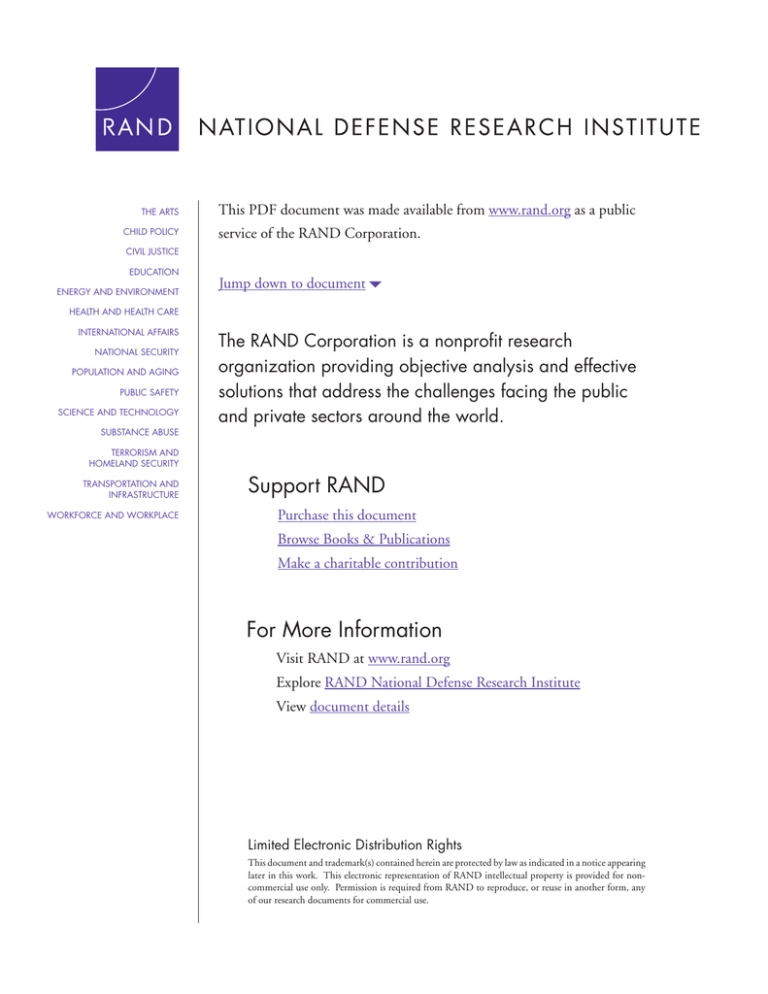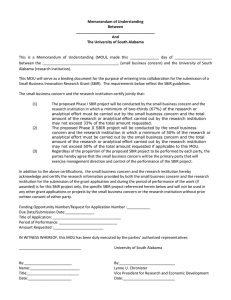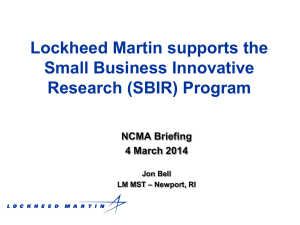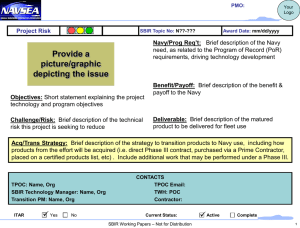
THE ARTS
CHILD POLICY
This PDF document was made available from www.rand.org as a public
service of the RAND Corporation.
CIVIL JUSTICE
EDUCATION
ENERGY AND ENVIRONMENT
Jump down to document6
HEALTH AND HEALTH CARE
INTERNATIONAL AFFAIRS
NATIONAL SECURITY
POPULATION AND AGING
PUBLIC SAFETY
SCIENCE AND TECHNOLOGY
SUBSTANCE ABUSE
The RAND Corporation is a nonprofit research
organization providing objective analysis and effective
solutions that address the challenges facing the public
and private sectors around the world.
TERRORISM AND
HOMELAND SECURITY
TRANSPORTATION AND
INFRASTRUCTURE
WORKFORCE AND WORKPLACE
Support RAND
Purchase this document
Browse Books & Publications
Make a charitable contribution
For More Information
Visit RAND at www.rand.org
Explore RAND National Defense Research Institute
View document details
Limited Electronic Distribution Rights
This document and trademark(s) contained herein are protected by law as indicated in a notice appearing
later in this work. This electronic representation of RAND intellectual property is provided for noncommercial use only. Permission is required from RAND to reproduce, or reuse in another form, any
of our research documents for commercial use.
This product is part of the RAND Corporation documented briefing series. RAND
documented briefings are based on research briefed to a client, sponsor, or targeted audience and provide additional information on a specific topic. Although documented
briefings have been peer reviewed, they are not expected to be comprehensive and may
present preliminary findings.
Evaluation and
Recommendations for
Improvement of the
Department of Defense
Small Business Innovation
Research (SBIR) Program
Bruce Held, Thomas Edison, Shari Lawrence Pfleeger,
Philip S. Antón, John Clancy
Prepared for the Office of the Secretary of Defense
Approved for public release; distribution unlimited
The research described in this report was prepared for the Office of the Secretary of Defense
(OSD). The research was conducted in the RAND National Defense Research Institute, a
federally funded research and development center sponsored by the Office of the Secretary
of Defense, the Joint Staff, the Unified Combatant Commands, the Department of the
Navy, the Marine Corps, the defense agencies, and the defense Intelligence Community
under Contract DASW01-01-C-0004.
ISBN 978-0-8330-3954-5
The RAND Corporation is a nonprofit research organization providing objective analysis
and effective solutions that address the challenges facing the public and private sectors
around the world. RAND’s publications do not necessarily reflect the opinions of its
research clients and sponsors.
R® is a registered trademark.
© Copyright 2006 RAND Corporation
All rights reserved. No part of this book may be reproduced in any form by any electronic or
mechanical means (including photocopying, recording, or information storage and retrieval)
without permission in writing from RAND.
Published 2006 by the RAND Corporation
1776 Main Street, P.O. Box 2138, Santa Monica, CA 90407-2138
1200 South Hayes Street, Arlington, VA 22202-5050
4570 Fifth Avenue, Suite 600, Pittsburgh, PA 15213-2665
RAND URL: http://www.rand.org/
To order RAND documents or to obtain additional information, contact
Distribution Services: Telephone: (310) 451-7002;
Fax: (310) 451-6915; Email: order@rand.org
vii
SUMMARY
This project comprised four parts. First, the study team gained a
broad understanding of the SBIR program. Next, the team evaluated the
DoD SBIR program’s success in terms of the current set of goals for the
program as measured by the department’s current set of SBIR metrics, as
well as by additional RAND-developed metrics. Since the DoD SBIR
program’s goals reflect little of DoD’s broader national security
mission, the third part of the study developed a set of DoD-specific
goals for its SBIR program that better reflect the national security
mission of the department. This task also entailed suggesting a number
of additional SBIR metrics to assess progress against the proposed
goals. The study concludes with a number of policy options, which, if
implemented, could make the DoD SBIR program more responsive to the
department’s broader defense mission.
THE DOD SBIR PROGRAM HISTORY AND STRUCTURE
The Small Business Innovation Development (SBID) Act of 1982
(Public Law 97-219) created the Small Business Innovation Research
(SBIR) program by mandating that all federal research, development,
test, and evaluation (RDT&E) agencies that award more than $100 million
in research and development (R&D) contracts annually create a SBIR
program and set aside 1.25 percent of that extramural R&D budget for
funding small business research awards. That set-aside percentage has
grown over two legislative reauthorizations of the program (Public Laws
102-564 and 106-554); it is currently set at 2.5 percent of DoD’s
extramural R&D budget. The SBID Act outlined four broad congressional
goals:
•
Stimulate technological innovation.
•
Use small businesses to meet federal R&D needs.
•
Foster and encourage participation by minority and
disadvantaged persons in technological innovation.
•
Increase the private-sector commercialization of innovations
derived from federal R&D.
viii
Over the years, Congress has emphasized the commercialization
aspects of the SBIR program. This emphasis has resulted in efforts to
both better measure commercialization and include it as a selection
criterion when making SBIR awards.
Congressional testimony prior to the reauthorizations, interim
General Accounting Office (GAO)1 reports, and the actual reauthorization
texts strongly suggest that Congress believes the SBIR program to be
effective in meeting its broader goals and will most likely continue to
support the program.
In 2003, the DoD SBIR program was about $900 million and
represented about 63 percent of the total federal SBIR budget, making it
the largest of the ten federal SBIR programs. The department’s 2004 and
2005 SBIR budgets exceed $1 billion.
DoD has decentralized administration of almost all aspects of its
SBIR program. This means that topic generation, budgeting, and research
emphasis are managed by the department’s military services and defense
agencies. At the Office of the Secretary of Defense (OSD) level, the
Office of Small and Disadvantaged Business Utilization (SADBU)2 manages
SBIR policy and the centralized solicitations for DoD’s entire SBIR
program. The Office of the Director of Defense Research and Engineering
within the Office of the Secretary of Defense for Acquisition,
Technology and Logistics (OSD AT&L) also has a role in the SBIR program;
it reviews (technically and administratively) research topics suggested
by the various military departments and agencies for redundancy,
clarity, and alignment.
The DoD SBIR program is structured into three phases: feasibility,
principal R&D, and commercialization. Small businesses initially compete
to win Phase I (feasibility) awards. The purpose of Phase I is to
determine the scientific and technical merit of the proposed effort.
Phase I contracts typically last up to six months and are normally
funded at $70,000 to $100,000. The SBIR Phase I awardees with the most
promising projects and results are invited to submit proposals for a
1
2
Now the Government Accountability Office.
Now the Office of Small Business Programs.
ix
Phase II contract. Phase II is intended as the primary R&D phase. Up to
two years and $750,000 may be allocated for Phase II performance. Phase
III is essentially any additional work that follows from Phase II,
although no SBIR funds are dedicated to Phase III. Instead, SBIR Phase
II finishers are expected to obtain private funding or other non-SBIR
federal funding to develop their research results for military or
commercial markets.
DOD SBIR PROGRAM GOALS AND METRICS
DoD’s broad goal for its SBIR program is “to harness the innovative
talents of our nation’s small technology companies for U.S. military and
economic strength.” Beyond this broad statement, however, DoD merely
restates the goals of the SBID Act:
•
Stimulate technological innovation.
•
Increase private-sector commercialization of federal R&D.
•
Increase small business participation in federally funded R&D.
•
Foster participation by minority and disadvantaged firms in
technological innovation.
As a result, evaluation of the DoD SBIR program focuses on these
four goals. Although the DoD SBIR program is aimed at defense-related
R&D through the topic selection process, there is currently no systemic
assessment of the extent to which the outcomes of the thousands of DoD
SBIR contracts completed to date have contributed to the department’s
primary national security mission.
The DoD SBIR program’s first goal--to stimulate innovation--has two
components. The first is the input side, “Stimulation.” This is measured
simply by counting the number of topics included in each solicitation,
the number of proposals received, the number of SBIR contracts awarded,
and ultimately how much money DoD spends on the program. The output
side, “Innovation,” is more difficult to measure, and there is, in fact,
little attempt to do so within DoD.
As a result, RAND’s evaluation of this goal focused on innovation.
The RAND study team noted that companies the Office of the Deputy Under
Secretary of Defense (Industrial Policy) identifies as
x
“transformational” make heavy use of the DoD SBIR program.3
Additionally, in a survey of companies that entered the DoD market
through the SBIR program, the study found that half the companies were
start-ups and that a significant number of patents were associated with
the start-ups. From this, the study team inferred that the SBIR program
was stimulating innovative activity. It was not clear, however, whether
this innovative activity was greater or less than a similar amount of
funding some other R&D program would generate.
The second goal—commercialization of federal R&D—is measured in two
ways: through “success stories” and the Commercialization Achievement
Index (CAI). “Success stories” are anecdotes of DoD SBIR
commercialization. While interesting, they provide little value in
determining overall commercialization success. More importantly, DoD has
developed the CAI, which measures the commercialization success of
previous SBIR Phase II award winners when they compete for new Phase I
awards. The introduction of the CAI is a positive development. It
provides a quantitative measure of commercialization success that
assists in evaluating both the individual small businesses and the
overall DoD SBIR program. That said, the CAI can be improved. Currently,
all information that is included in the CAI is self-reported by the
small businesses with their Phase I proposals, and no auditing is done
to validate the figures. Additionally, the CAI is not applied to as many
companies as it could be, nor does it seem to act as a strong
discriminator when selecting Phase I awardees.
The RAND study team looked for additional indicators of
commercialization activity. The team noted, for example, that in a
sample of 40 SBIR companies, commercial success in two cases could be
linked to the SBIR program. An examination of non-SBIR DoD contracting
also found that in a sample of almost 500 DoD SBIR award winners
entering the DoD market through the SBIR program, the cumulative value
of the non-SBIR contracts these companies were awarded by DoD exceeded
the cumulative value of their DoD SBIR contracts. This finding is
3 The report that identified companies as transformational (DoD,
2003b) did not define “transformational.” We made the assumption that
some level of innovation was implied in the term.
xi
mitigated, however, by the fact that 95 percent of the non-SBIR
contracting was concentrated in just 1 percent of the sample.
The DoD SBIR program goal of increasing small business
participation in federally funded R&D is measured by the dollars spent
on the program. The current size of the DoD SBIR program, about $1
billion per year, has been achieved through an average annual growth
rate of about $43 million per year over the past 20 years, ensuring that
small business participation in the program has increased. Additionally,
the program introduces small businesses to the DoD market. DoD claims
that a third of the companies awarded Phase I contracts are new to the
DoD market.
RAND’s evaluation of the goal to increase small business
participation in federal R&D found that over the past decade, 20 to 25
percent of the companies winning DoD SBIR awards, 375 in 2003 alone,
were new to the DoD market. However, the RAND study team also found that
the SBIR program represents a relatively small part (less than 25
percent) of DoD’s R&D contracting with small businesses.
DoD measures the goal of fostering participation by minority and
disadvantaged firms in technological innovation by counting the number
of firms claiming women- and minority-owned status. According to DoD,
the percentage of these kinds of firms in its SBIR program has grown
over time and now represents approximately 20 percent of participating
small businesses.
Rather than looking at the number of women- and minority-owned
firms participating the SBIR program, RAND examined the value of the DoD
SBIR contracts going to these firms and compared this to the value of
all DoD R&D contracts going to small, minority-, or women-owned
businesses. The findings indicate that, while the SBIR program has
succeeded in contracting with women- and minority-owned firms, the
percentage of SBIR dollars going to these firms is smaller than the
percentage of dollars going to similar firms across all DoD R&D
contracts with small, minority-, or women-owned businesses. This is most
likely due to the fact that there are other programs aimed specifically
at increasing the rate at which disadvantaged small businesses
participate in federal contracting. These programs give economically or
socially disadvantaged firms advantages in competition for federal
xii
contracts. The DoD SBIR program does not provide these advantages to
disadvantaged small businesses, and therefore these companies will
naturally tend to migrate to the programs that do.
Based on both DoD’s own measures and this study’s examination of
the available data, it appears that the DoD SBIR program generally
accomplishes the goals set out in the program’s enabling legislation.
That is, the legislated amount of money is spent on R&D contracts with
small businesses, hence “stimulating” innovation. On the output side of
the R&D process, companies identified as “transformational” take greater
advantage of the SBIR program, and there is some level of patenting
activity, directly and indirectly, associated with the program. Some
commercialization of federal R&D also appears to occur as a result of
the SBIR program, although how effective the SBIR program is in this
area is unclear. The DoD SBIR program clearly attracts a large number of
small businesses to the DoD R&D market, and, on average, roughly 250 per
year are new to that market. Finally, the SBIR program provides
opportunities for minority- and women-owned small businesses to win R&D
contracts with DoD, although there seem to be other, more effective
programs in DoD for this purpose.
OTHER RAND FINDINGS
During the examination of the SBIR program, the study team found
additional information that did not relate directly to the current goals
of the DoD SBIR program. These provide additional insights.
In general, DoD’s SBIR topic allocation aligns well with the
department’s R&D priorities while remaining flexible enough to focus
topics in areas that are more appropriate for small businesses. That
said, the team found that the bulk of the SBIR contracts are focused on
basic and applied research rather than later-stage development.
DoD SBIR topics are added at the rate of about one topic for every
$2 million of additional budget. This marks a departure from the first
decade of the program, when more than three topics were added for every
$1 million of budget. This change means that more dollars are now
available to address each topic, resulting in more Phase I and II
contracts awarded per topic.
xiii
One issue that is generally included in any discussion of the SBIR
program is the perception that there are companies that are frequent
award winners. The study team found that frequent award winners do win a
large percentage of the total SBIR contracts: 29 percent of all DoD SBIR
Phase I contracts in the 1993–2002 period went to companies that won 20
or more SBIR Phase I contracts in that timeframe. More interestingly,
this phenomenon is increasing. In 1994, 12 percent of all DoD SBIR Phase
I contracts were with companies that had more than five SBIR contract
actions in that year alone. By 2003 that percentage had doubled to 25
percent. In addition, the contracting data indicate that the ratio of
DoD non-SBIR contract dollars to DoD SBIR contract dollars won by a
company generally decreases as the number of SBIR contracts won
increases. In other words, frequent SBIR award winners rely more, as a
percentage of revenue from DoD, on the SBIR program than occasional SBIR
winners do. This pattern may be on the decline, however. In the ten-year
period from 1994 to 2003, the ratio of DoD non-SBIR contract dollars to
DoD SBIR contract dollars significantly increased for frequent DoD SBIR
winners. That trend should continue if the CAI is rigorously used as
part of the selection criteria for SBIR awards.
More troubling was a finding that the DoD SBIR program is managed
in a manner that may be too lean. While the study team expected the SBIR
program to require greater-than-average management attention, the
opposite seems to be the case. Resources to manage DoD contracts are
generally about 2.7 percent of total contract value. The SBIR program,
with the Department of the Navy as the exception, invests just 2 percent
of the contract value to SBIR program management. In contrast, venture
capital companies, perhaps the best commercial analogy to the DoD SBIR
program, earn management fees that range from 2.5 to 5 percent of the
fund size and also earn a significant percentage (usually around 20
percent) of return on investment.
This finding reinforces the study team’s perception that the
primary purpose of participation in the SBIR program, from DoD’s
perspective, is statutory compliance with the SBID Act. In other words,
within DoD the SBIR program is managed more as a tax and burden to be
borne than as an R&D resource to be leveraged. The study team initially
got this impression during interviews with SBIR managers at the
xiv
component and agency levels. It was reinforced as the study team took
advantage of a number of opportunities to talk to personnel in DoD labs
and program offices about the SBIR program. While these discussions
cannot be described as anything more than anecdotal, they nonetheless
reinforced the impression that the R&D and acquisition leadership within
DoD has been generally unenthusiastic about the SBIR program. Reactions
about the SBIR program from small businesses were much more mixed. We
found examples of small businesses using the SBIR program in a number of
ways: as capital to help new businesses get established, as an entrée
into the DoD market, as low-risk capital to conduct high-risk R&D, and
as a revenue source for R&D service companies.
RECOMMENDATIONS FOR IMPROVING THE DOD SBIR PROGRAM
The findings of the study team, along with the very substantial
size of the DoD SBIR program, naturally lead to the question of how the
program could be improved so that DoD can leverage its resources for the
department’s national security mission while continuing to meet the
statutory goals Congress established for the program.
There are three fundamental steps for improving the program. These
three steps are all aimed at maximizing the value of the program to DoD
rather than merely minimizing its budgetary impact. First, there needs
to be continued emphasis within the defense R&D and acquisition
communities, particularly at the leadership level, that the SBIR program
is an investment that can generate a significant return. At $1 billion
per year, the DoD SBIR program is large enough to warrant substantial
leadership attention. Importantly, these funds are very flexible and can
be applied to specific problems and priorities without negotiating
through the standard R&D programming and budgeting processes. Second,
DoD-specific SBIR goals and metrics must be established. Finally,
resources must be made available to manage the R&D outcomes from the
SBIR program, not just the funding and contracting processes.
The SBIR program can be a part of the Acting Under Secretary of
Defense’s (Acquisition, Technology and Logistics) seven goals targeted
at driving performance outcomes.4 Two of these, technology dominance and
4 The acting Under Secretary of Defense for Acquisition, Technology
and Logistics at the time of this study, and the source of the seven
xv
strengthening the industrial base, are particularly applicable to the
SBIR program. Six SBIR-specific goals that address these broader aims
are:
Technology dominance
1. Improve invention-to-use time for military technologies.
2. Provide technology intelligence about what development
exists or is planned in the United States.
3. Generate innovative solutions to DoD requirements.
Improving the industrial base
4. Broaden DoD’s technological base and increase competition by
building and strengthening innovative companies willing to
do defense work.
5. Improve ties between prime contractors and the small,
technology-oriented business community.
6. Expand intellectual capital in the United States.
POLICY OPTIONS FOR THE DOD SBIR PROGRAM
The study team identified a number of policy options for using the
DoD SBIR program in ways that can help achieve these goals. In most
cases, these options will require that the department invest additional
resources into the SBIR program, but such investment holds the promise
of extracting much greater value in terms of R&D outcomes from the SBIR
program.
1. Emphasize later-stage R&D (6.3, 6.4, and 6.7 stages) rather
than basic and applied research in topic selection.
2. Establish a quick-reaction SBIR program that utilizes SBIR
resources to address the immediate operational requirements of
DoD.
3. Use the SBIR program to understand developments in the
commercial technology sector that are not being addressed in
other defense-related R&D.
goals, was Michael Wynne. Since this study was completed, Kenneth Krieg
has been nominated and confirmed to the position, replacing Mr. Wynne.
xvi
4. Write some DoD SBIR topics to address operational, rather than
technical, needs in order to explore innovative approaches to
solving operational problems.
5. Use the DoD SBIR program as a tool to recruit small businesses
that are successful in other federal markets into the DoD
market.
6. Combine and integrate the resources of the DoD SBIR program
with other DoD R&D funding programs, such as venture capital
initiatives and the Manufacturing Technology Program, to
provide a stream of funding at all stages of the product
development cycle.
7. Look for greater opportunities to involve the defense prime
contractors in the DoD SBIR program through mentoring and
partnership arrangements with small businesses, such as by
linking the SBIR program with the DoD Mentor-Protégé program or
by facilitating consultation between DoD and the larger system
contractors to identify potential SBIR projects and small
businesses of most interest to those contractors managing
larger system development.
8. Use the SBIR program to resource a more complex, larger product
development effort, such as a small system acquisition program
or advanced technology demonstrator, by combining a number of
SBIR contracts over a period of time.






